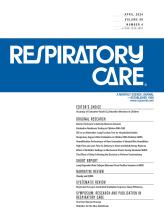This article requires a subscription to view the full text. If you have a subscription you may use the login form below to view the article. Access to this article can also be purchased.
Abstract
BACKGROUND: Aerosol barrier enclosure systems have been designed to prevent airborne contamination, but their safety has been questioned. A vacuum tent was designed with active continuous suctioning to minimize risks of aerosol dispersion. We tested its efficacy, risk of rebreathing, and usability on a bench, in healthy volunteers, and in an ergonomic clinical assessment study.
METHODS: First, a manikin with airway connected to a breathing simulator was placed inside the vacuum tent to generate active breathing, cough, and CO2 production; high-flow nasal cannula (HFNC) was applied in the manikin’s nares. Negative pressure was applied in the vacuum tent’s apex port using wall suction. Fluorescent microparticles were aerosolized in the vacuum tent for qualitative assessment. To quantify particles inside and around vacuum tent (aerosol retention), an airtight aerosol chamber with aerosolized latex microparticles was used. The vacuum tent was tested on healthy volunteers breathing with and without HFNC. Last, its usability was assessed in 5 subjects by 5 different anesthesiologists for delivery of full anesthesia, including intubation and extubation.
RESULTS: The vacuum tent was adjusted until no leak was visualized using fluorescent particles. The efficacy in retaining microparticles was confirmed quantitatively. CO2 accumulation inside the vacuum tent showed an inverse correlation with the suction flow in all conditions (normal breathing and HFNC 30 or 60 L/min) in bench and healthy volunteers. Particle removal efficacy and safe breathing conditions (CO2, temperature) were reached when suctioning was at least 60 L/min or 20 L/min > HFNC flow. Five subjects were successfully intubated and anesthetized without ergonomic difficulties and with minimal interference with workflow and an excellent overall assessment by the anesthesiologists.
CONCLUSIONS: The vacuum tent effectively minimized aerosol dispersion. Its continuous suction system set at a high suction flow was crucial to avoid the spread of aerosol particles and CO2 rebreathing.
- respiratory protective devices
- aerosolized particles and droplets
- patient-to-professional disease transmission
- infectious disease droplet transmission
- respiratory aerosols and droplets
- capnography
- microspheres
Footnotes
- Correspondence: Laurent Brochard MD, 209 Victoria Street, Room 408, Toronto, Ontario, M5B 1T8, Canada. E-mail: Laurent.Brochard{at}unityhealth.to
Dr Rezende-Neto invented the vacuum tent and is the cofounder of InventoRR MD. Dr Brochard’s laboratory discloses relationships with STIMIT, Medtronic, Dräger, Sentec, Philips, and Fisher & Paykel. The remaining authors have disclosed no conflicts of interest.
Dr Masy presented a version of this paper at Critical Care Canada Forum 2021, held virtually December 6–8, 2021.
The study was funded by a COVID-19 research grant, Division of General Surgery, St. Michael’s Hospital, Toronto, Ontario, Canada.
MD Precision provided vacuum tent devices for this study.
Supplementary material related to this paper is available at http://www.rcjournal.com.
See the Related Editorial on Page 519
- Copyright © 2024 by Daedalus Enterprises
Pay Per Article - You may access this article (from the computer you are currently using) for 1 day for US$30.00
Regain Access - You can regain access to a recent Pay per Article purchase if your access period has not yet expired.







